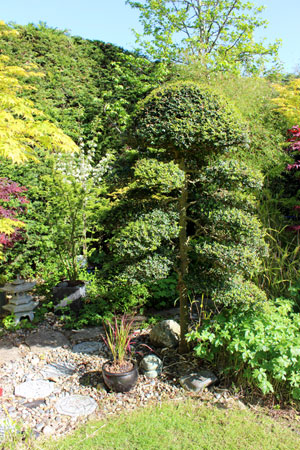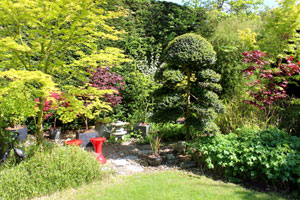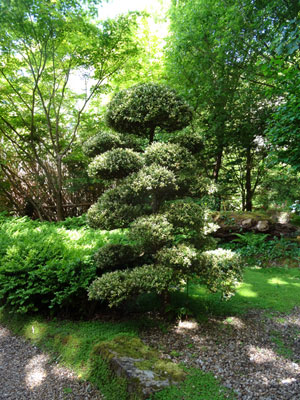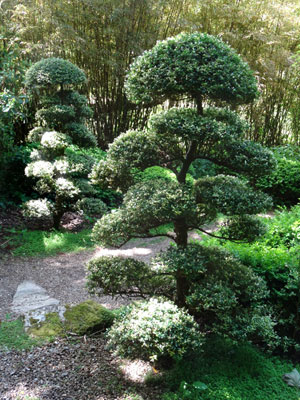Garden Cloud Trees
Japanese Garden Design

Something quite special in any Japanese garden is a cloud tree or 'Niwaki', which appears rather like a giant bonsai and can be created from a number of different evergreen species, preferably those with small leaves and naturally coompact foliage growth.
Usually comprising a single slightly bendy trunk, these simply stunning trees are treated in the same way as formal topiary, with their individual branches being pruned to form rounded, oval foliage pads.
Specimen Trees
Cloud-pruned trees are best positioned on their own as specimen plants, so that their full form and structure can be properly appreciated from a distance, without branches of nearby maples or bamboo canes hiding the outline and spoiling the overall appearance.
Suitable Species

If you are planning to create your very own cloud tree, then try to select a large bushy tree to start with.
Particularly suitable species include Japanese holly (ilex crenata 'kimne'), box / boxwood (buxus sempervirens), Italian privet (ligustrum ovalifolium jonandrum), Japanese privet (ligustrum japonicum) and myrtle (myrtus), as well as yew (taxus baccata) and many other conifer species, such as white and black pines (pinus parviflora and nigra).
Select a tree that has an interestingly shaped trunk and plenty of branches to choose from, and then adopt basic bonsai styling principals. Choose alternating branches (right, back, left), with the first left and right branches facing forwards. The branches will likely need to be positioned in place with bonsai wire or tied downwards with string. Your end result should look almost like a sparse pom-pom tree, with plenty of room for the branches to grow into dense foliage clouds over the years to come.

Italian privet is an excellent species when used in the creation of topiary and Japanese cloud trees, since it grows extremely quickly. However, on the down side, its vigorous growth habit means that it will therefore need to be pruned several times during the growing season.
Japanese holly is the traditional species for this treatment, although it is much slower growing and it will therefore take considerably longer to achieve your end result of spreading foliage 'lollipops'.
Pruning Pine Trees
Most varieties of pine tree respond well to candle pruning techniques, which promote both denser growth and back budding. However, training a pine as a cloud tree is more difficult than a holly or privet bush, requiring a knowledge of how pines grow and respond to pruning in this way.
The initial styling of a pine is also often a little tricky, since the branches tend to emerge in spaced out cartwheel-type arrangements, meaning that it is hard to create a bonsai shape unless you are able to select a bushy pine to start with.

Design and Training
As your tree grows each year, you should aim for an overall shape that is not too symmetrical, with plenty of space between the branches so that the many foliage clouds can be fully appreciated.
It may be necessary to remove a branch or two if the appearance becomes too bushy and less tree-like.
Cloud Hedges
If you have a long evergreen hedge of a medium height that will bud back on bare wood, such as yew or box plants, then you could perhaps prune it into a long line of curving cloud shapes, which can make a pleasant change from harsh straight lines.
 Something quite special in any Japanese garden is a cloud tree or 'Niwaki', which appears rather like a giant bonsai and can be created from a number of different evergreen species, preferably those with small leaves and naturally coompact foliage growth.
Something quite special in any Japanese garden is a cloud tree or 'Niwaki', which appears rather like a giant bonsai and can be created from a number of different evergreen species, preferably those with small leaves and naturally coompact foliage growth. If you are planning to create your very own cloud tree, then try to select a large bushy tree to start with.
If you are planning to create your very own cloud tree, then try to select a large bushy tree to start with. Italian privet is an excellent species when used in the creation of topiary and Japanese cloud trees, since it grows extremely quickly. However, on the down side, its vigorous growth habit means that it will therefore need to be pruned several times during the growing season.
Italian privet is an excellent species when used in the creation of topiary and Japanese cloud trees, since it grows extremely quickly. However, on the down side, its vigorous growth habit means that it will therefore need to be pruned several times during the growing season.